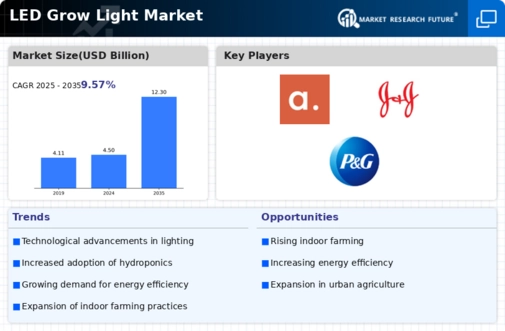Top Industry Leaders in the LED Grow Light Market

The Competitive Landscape of the LED Grow Light Market
The LED grow light market, where photons dance and plants flourish, is flourishing itself, pulsating with intense competition and innovative solutions. Understanding the strategies, key players, and future trends is crucial for businesses navigating this fertile terrain and capitalizing on its blossoming potential.
Key Player:
- Epistar Corporation
- Signify
- Iwasaki Electric Co. Ltd
- Everlight Electronics Co. Ltd
- Illumitex Inc.
- OSRAM Licht AG
- LumiGrow Inc.
- Heliospectra AB
- Lemnis Oreon BV
- Iwasaki Electric Co. Ltd.
Strategies Adopted by Leaders:
- Spectrum Optimization: Leading players like Philips and Osram are prioritizing research into plant-specific lighting recipes, tailoring light spectrums to maximize growth and yield for different crops (Source: Philips Horticulture press release, Osram website).
- Focus on Efficiency and Energy Savings: Delivering high light output with minimal energy consumption is paramount. Fluence by OSRAM leverages innovative LEDs and optical designs for efficiency, while Gavita focuses on modular systems for optimal light distribution and reduced energy waste.
- Smart Lighting and Automation: Integrating sensors, timers, and control software allows for automated scheduling and remote monitoring, optimizing growth conditions and reducing labor costs. GE Current, a Daintree company, prioritizes smart grow light systems with data analytics, while Signify (formerly Philips Lighting) offers remote management platforms for large-scale greenhouse operations.
- Cost-Effectiveness and Scalability: Making LED grow lights affordable is crucial for wider adoption, especially in emerging markets. California Lightworks prioritizes mass production and economies of scale for cost-efficiency, while Spider Farmer focuses on budget-friendly solutions for hobbyists and home growers.
- Focus on Niche Applications and Partnerships: Addressing specific needs can be lucrative. Heliospectra specializes in high-precision lighting for vertical farming and controlled-environment agriculture, while Apogee Instruments collaborates with research institutions to develop cutting-edge light measurement tools for optimizing grow light systems.
Factors for Market Share Analysis:
- Brand Reputation and Technological Expertise: Established players like Philips and Osram hold an advantage with proven track records, extensive research and development capabilities, and strong relationships with agricultural technology companies. This legacy inspires trust and facilitates adoption in large-scale projects.
- Spectrum Technology and Customization: Offering advanced spectra and the ability to tailor light recipes for specific crops and growth stages caters to diverse user needs and maximizes plant yields. Fluence by OSRAM's customized lighting solutions exemplify this approach.
- Efficiency and Sustainability: Delivering superior light output with minimal energy consumption and utilizing eco-friendly materials resonates with environmentally conscious consumers and growers. GE Current's energy-efficient systems and Signify's focus on recyclable components are noteworthy examples.
- Manufacturing Capacity and Scalability: Having efficient production facilities and the ability to ramp up production is crucial for meeting growing demand, especially in high-growth markets like Asia. California Lightworks' large-scale production capabilities and Spider Farmer's focus on efficient supply chains offer advantages.
- Innovation and Partnerships: Investing in R&D and collaborating with other companies accelerates technology development and market access. Heliospectra's innovative lighting systems for vertical farming and Apogee Instruments' partnerships with research institutions demonstrate this approach.
New and Emerging Companies:
- Phytofy Inc.: Pioneering AI-powered grow light systems with real-time plant and environmental monitoring, enabling data-driven lighting adjustments for optimal growth.
- GrowFlux: Specializing in high-intensity LEDs and modular lighting systems for large-scale cannabis cultivation, offering efficiency and scalability.
- Purple LED: Focusing on blue-violet spectrum LEDs, optimized for specific plant responses like increased flowering and higher cannabinoid production.
- NextLight Systems: Developing cutting-edge LED fixtures with integrated sensors and software for automated control and remote monitoring in commercial greenhouses.
Latest Company Updates:
Epistar Corporation:
- October 20, 2023: Epistar announces its new high-efficacy horticulture LED chips with improved light output and efficiency, targeting professional growers seeking maximum yield optimization
- July 12, 2023: Epistar collaborates with a leading lighting manufacturer to develop custom LED modules for vertical farming applications, focusing on compact design and precise spectrum control
Signify (formerly Philips Lighting):
- October 17, 2023: Signify unveils its newest high-pressure sodium (HPS) replacement LED grow lights, offering equivalent light output with significant energy savings, targeting cost-conscious growers making the switch to LEDs
- July 6, 2023: Signify expands its Philips GreenPower LED production module for indoor agriculture, offering modularity and scalability for large-scale greenhouse operations
